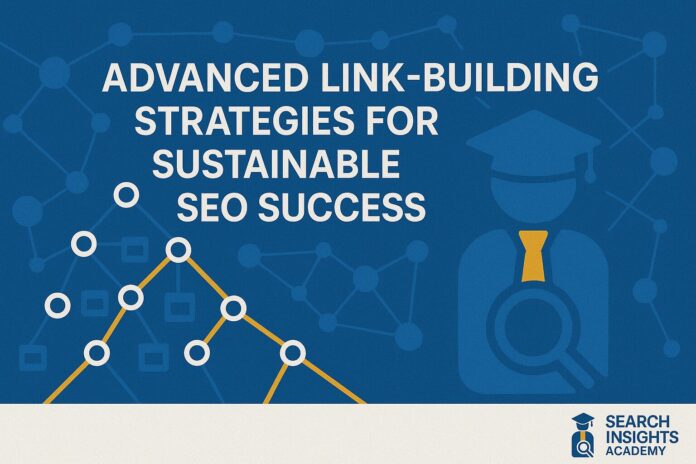Link building remains a cornerstone of effective SEO, with recent data confirming that modern link equity comes from relevance, authority, and relationship depth rather than mere volume. This comprehensive guide explores advanced link-building strategies that align with Google’s latest algorithm updates and industry best practices to help you build a robust, sustainable backlink profile.
Understanding Modern Link Building in 2025
The link building landscape continues to evolve, with guest posting remaining one of the most popular tactics in 2024. However, the most effective approaches are shifting significantly. According to a recent survey conducted by Editorial.link on 113 SEO experts, Digital PR stands out as the clear favorite among link-building techniques, with 67.3% of respondents considering it the most effective. Guest posting follows in second place with 38.9% of experts believing it highly effective.
Data shows some conflicting information about which tactics are most widely used. While Authority Hacker found that guest posting, followed by link exchanges, and creating content were the top tactics used today, Aira’s report found that content-led link building was most popular, with guest posting ranked last. Another study by uSERP in 2022 showed digital PR and content marketing were most popular with guest posting in third position. Despite these variations, we know that many SEOs are using guest posting extensively.
The consensus now is that “gone are the days when success was measured by the sheer volume of low-quality links. Now it’s apparent that the quality and relevance of backlinks are far more important.”
Let’s explore the strategies that are delivering results in today’s environment.
Hypothesis & Method: Building Sustainable Link Equity
Our approach is based on a clear hypothesis: sustainable link building that withstands algorithm updates requires a diverse strategy focused on quality and relevance rather than quantity alone. To test this hypothesis, we’ll examine multiple link-building methods, their effectiveness metrics, and practical implementation steps.
Tools for Evaluating Link Building Success
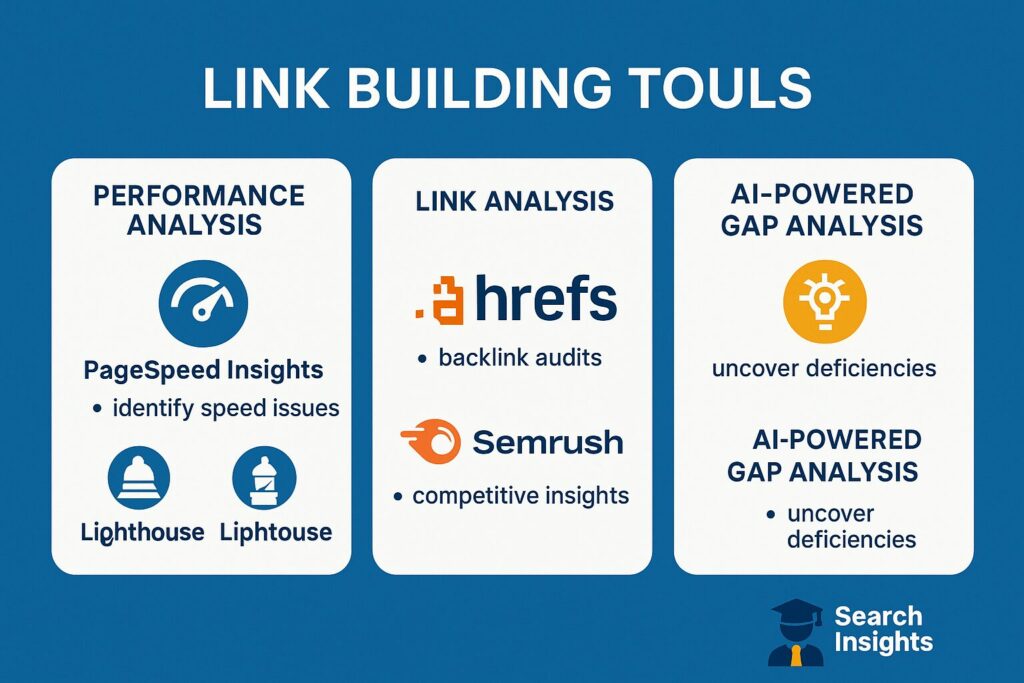
Google regularly updates its spam detection systems to combat various forms of search spam, including link spam. Websites impacted by spam updates should review Google’s policies to ensure compliance. Google’s SpamBrain, an AI-based spam prevention system, continues to improve its ability to detect new and existing spam types.
For effective measurement and monitoring, we recommend these essential tools:
- PageSpeed Insights and Lighthouse: These tools help analyze your site’s technical performance, which is crucial because slow-loading pages with poor user experience are less likely to attract quality backlinks.
- Link Analysis Tools: While Ahrefs shows you basic data like search volume, CPC, and competition, Semrush offers more in-depth data with its Keyword Overview tool that provides deeper, more actionable insights. The tool adds a layer of personalization and analytical precision powered by AI, allowing you to better align with specific SEO goals. For example, its Topical Authority feature checks how authoritative your domain is on certain topics, helping you pinpoint where you can perform better in search rankings.
- AI-Powered Link Gap Tools: Many professionals value “the feature that lets you analyze the keyword and backlink gap with your competitors. This is very useful in determining which keywords you aren’t ranking for, that you could be getting.”
Key Findings in Effective Link Building for 2025
1. Link Economics & Investment Reality
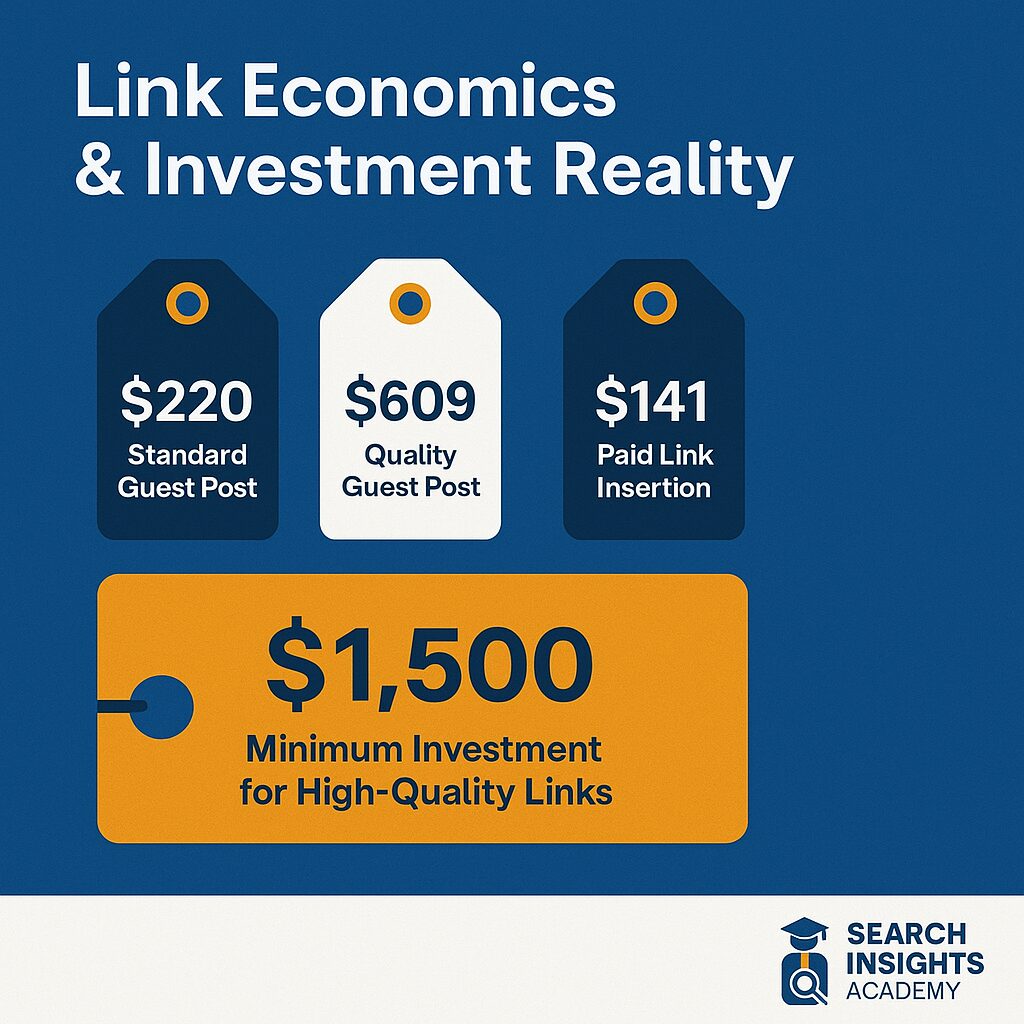
Recent data shows that the average price for a guest post is approximately $220, while a “quality” guest post costs around $609. These figures come from analyzing over one thousand unique guest posting sites over an eight-month period.
Most link-building vendors charge between $500 and $1,250 per link, with methods like guest posts and paid links being common. According to BuzzStream’s research, the average cost of a guest post is $220, while a high-quality guest post can reach up to $609. For paid link insertion, the typical price is $141.
The investment required is significant: “You should be willing to spend at least $1,500 to get a high-quality, non-syndicated, dofollow link in 2024,” whether investing in an agency, freelancer/consultant, or in-house team. The goal, however, should be to lower that cost “by creating great link building campaigns” with effective strategies.
2. Digital PR: The New Frontrunner
The clear winner among link-building tactics in 2024 is Digital PR. A significant 67.3% of SEO experts would choose it as their go-to strategy if resources allow. This approach involves creating newsworthy content and building relationships with journalists and publishers.
According to Siege Media, in 2024, the cost of Digital PR links depends on how complex your campaign is. For simpler campaigns with a naturally engaging story, expect to spend between $5,000 and $10,000 a month. If your business needs custom content creation, the cost increases to around $8,000 to $15,000 a month. For individual high-quality placements, you’re looking at about $800 to $1,200 each, though you might pay less if your content catches fire and goes viral.
3. Multi-Touch Outreach Effectiveness
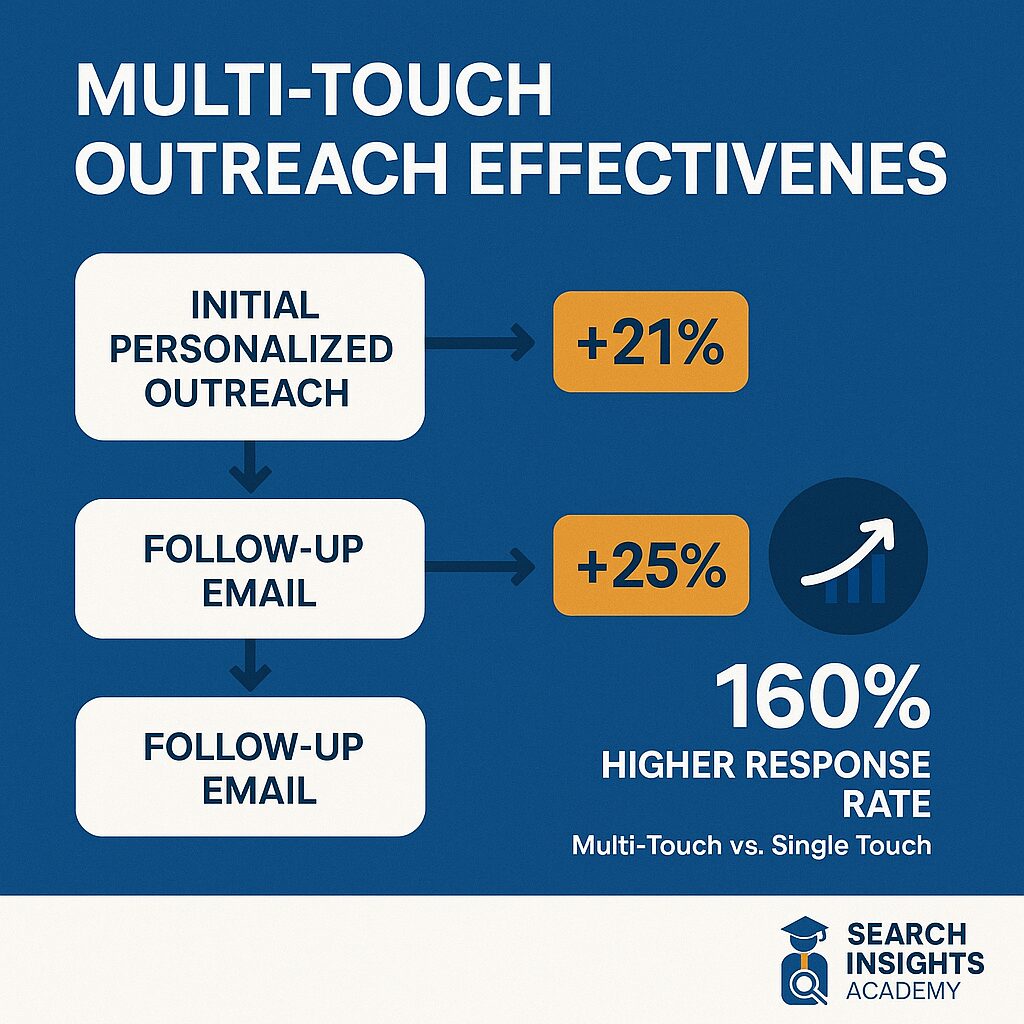
The most successful outreach campaigns reach out to multiple contacts multiple times. Email sequences with multiple attempts and multiple contacts boost response rates by 160%.
In 2024, email sequences that include multiple contacts and messages deliver significantly better results. Research from Backlinko shows that a well-crafted sequence has a 160% higher response rate than a single email. It’s recommended not to hesitate in reaching out to a few relevant contacts within the same company, and to consider follow-up emails to increase the chances of a successful conversation. While the impact may be subtle, linking to your social profiles in your email signature can nudge recipients toward a positive response.
4. Broken Link Building: Hard to Scale but Highly Effective
Broken link building is a strategy that, while not always easy to scale, makes up for it with its high success rate. The process involves finding broken links, reaching out to site owners, and offering to replace the broken link with your resource. The easiest way to do this is to first find dead pages on competing websites, then extract any backlinks still pointing to that page (if you can provide them with a fitting substitute for the broken link).
Despite its high success rate, broken link building can be difficult to scale as it relies entirely on your competitors having broken pages, which makes this SEO strategy somewhat inconsistent. It may be especially lucrative for local SEO if you know a local competitor has gone out of business, but such cases are rare.
But it pays off over time because of the increased conversion rate. If the end result is a link from a high-quality site that you perhaps otherwise would not have gotten, showing them a list of broken links and broken pages is a good investment of your time.
5. Risk Controls Post-2024 Spam Updates
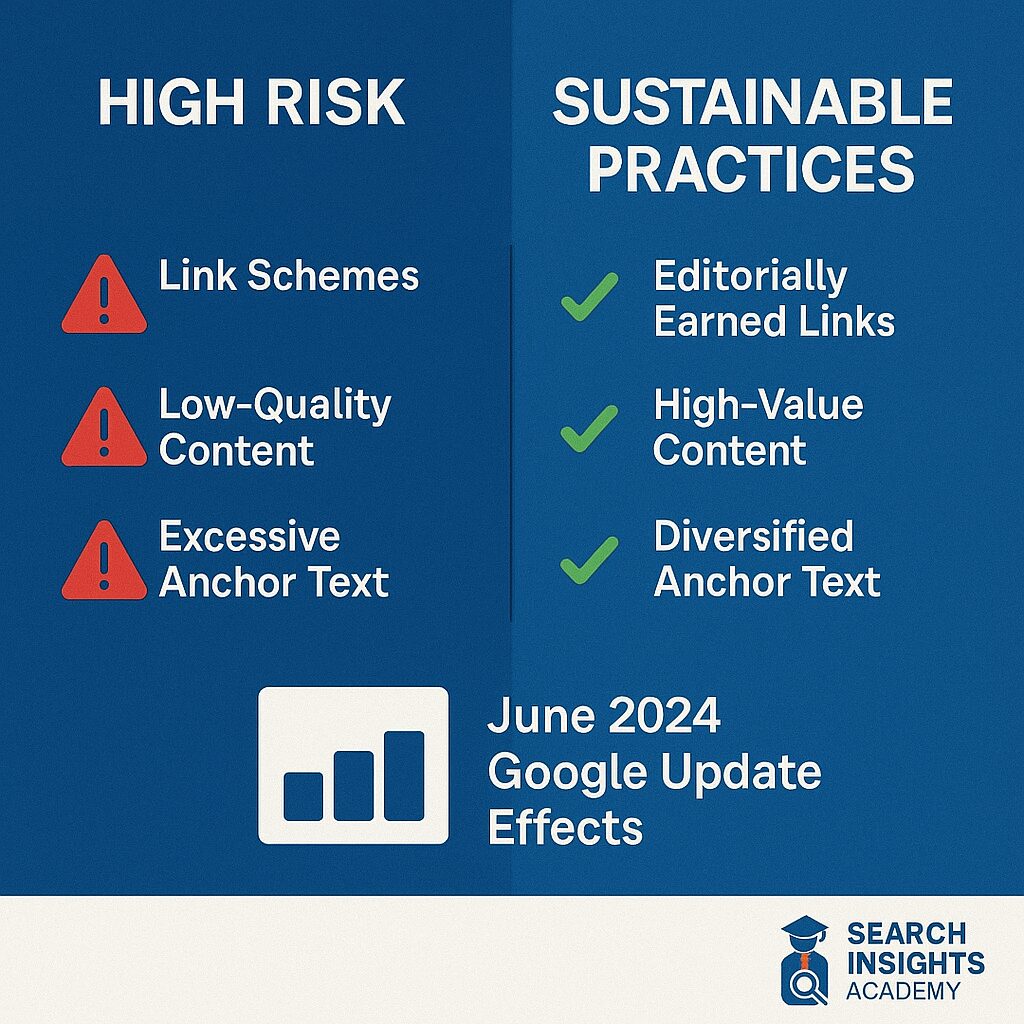
Sites that violate Google’s policies may rank lower in results or not appear in results at all. Making changes may help a site improve if automated systems learn over time that the site complies with spam policies. However, in the case of a link spam update (which specifically deals with link spam), making changes might not generate an improvement because when Google’s systems remove the effects of spammy links, any ranking benefit those links previously provided is permanently lost.
In June 2024, Google announced a new spam update to combat spammy link tactics and manipulation. This update had major repercussions in the link building and SEO industry. After evaluating 50 sites in the SaaS space, more than half were hit by the Link Spam Update. The primary signal of a link spam penalty was an abrupt flat traffic plateau starting in June 2024, despite steadily rising link numbers.
In the wake of Google’s clampdown on spam (with the latest update announced in June 2024), it’s getting harder to abuse the link system. The algorithm has become too sophisticated to allow for meaningful performance using shady tactics. When building backlinks, quantity is no longer the way forward. The best approach is to focus on links from relevant, high-authority sites that provide a helpful bridge for users in your industry.
6. Automation and AI Toolkit Integration
LinkDoctor.io takes a tailored, strategic approach to link building by creating a custom plan designed around business goals for long-term results. They don’t follow a one-size-fits-all approach, instead giving each project the attention it needs. They offer flexible pricing options based on business needs, with packages for businesses of all sizes, and can customize plans based on factors like competition and industry.
Modern link building is increasingly relying on AI-powered tools for:
- Prospect identification
- Personalized outreach
- Content generation for link assets
- Link quality scoring
- Monitoring and reporting
Semrush’s Keyword Overview tool gives you deeper, more actionable insights by adding a layer of personalization and analytical precision powered by AI, allowing you to better align with your specific SEO goals. For example, Topical Authority checks how authoritative your domain is on certain topics, helping you pinpoint where you can shine in search rankings. It analyzes content quality and relevance to help predict how well your content will perform. Another useful metric is Personal Keyword Difficulty (PKD %), which gives you customized keyword difficulty scores for your domain, making them more relevant to your specific situation and helping you identify domain-specific keyword opportunities that are easier to rank for.
Recommended Strategic Approaches
Based on our findings, here are the most effective link-building strategies to implement in 2025:
1. Quality-Focused Guest Posting
Following the March 2024 Google update, many guest posting sites saw significant traffic drops. After analyzing over 1,100 sites, only about 68 (just 6%) remained viable quality sites. This dramatic drop doesn’t mean that lower domain authority or traffic sites have no value—some might be new and still growing—but you must factor this into your link building pricing and strategy.
Implementation Steps:
- Focus on relevance over domain metrics
- Invest in comprehensive, data-driven content
- Build relationships with editors rather than one-off submissions
- Include original research or proprietary data where possible
2. Strategic Digital PR Campaigns
Digital PR is gaining traction among experienced SEOs. While only 17.7% of SEOs currently use digital PR, its popularity grows by 433% as SEO experience increases.
Implementation Steps:
- Develop newsworthy angles tied to current trends
- Create original research or data studies
- Prepare reactive content for newsjacking opportunities
- Build relationships with journalists in your industry
- Track placement quality rather than quantity
3. Effective Multi-Touch Outreach Sequences
Sending follow-up emails is crucial for successful cold email outreach. Cold email expert Alex Berman testifies that most of his cold emails never got a reply until he followed up. Sending the first follow-up boosts your chance of getting a reply by 21% and a second one by 25%. Longer follow-up emails (around 150 words) increase your chances of booking a meeting by 15x. Always reiterate the content of your first email in your follow-ups and never send a follow-up without context, as prospects might be getting hundreds of emails that could have buried your first message.
Implementation Steps:
- Create personalized initial outreach emails
- Plan 2-3 follow-up messages with increasing value
- Space follow-ups appropriately (3-5 days apart)
- Add new information or value in each follow-up
- Track response rates by message in the sequence
4. Targeted Broken Link Building
While harder to scale, broken link building remains highly effective when done strategically.
Implementation Steps:
- Identify resource pages in your niche
- Use tools like Check My Links to find broken links
- Create superior replacement content
- Personalize outreach to highlight the value of your resource
- Follow up with site owners who don’t respond initially
5. Link Gap Analysis and Competitor Backlink Acquisition
Depending on how competitive your niche is, you may see varying levels of success with the competitor backlinks strategy. If you were to run a competitor link building campaign manually, you would require access to backlink monitoring software, such as SEMRush or Ahrefs. However, if you choose Respona to speed up your link building campaigns, you don’t even need those tools – Respona is integrated with Moz and lets you extract competitors’ backlinks even without an Ahrefs account.
Implementation Steps:
- Use AI-powered tools to identify link gaps
- Prioritize targets that link to multiple competitors
- Create superior content that deserves the link
- Personalize outreach based on existing relationship with competitor
- Track conversion rates by competitor source
Putting It All Together: Your Action Plan
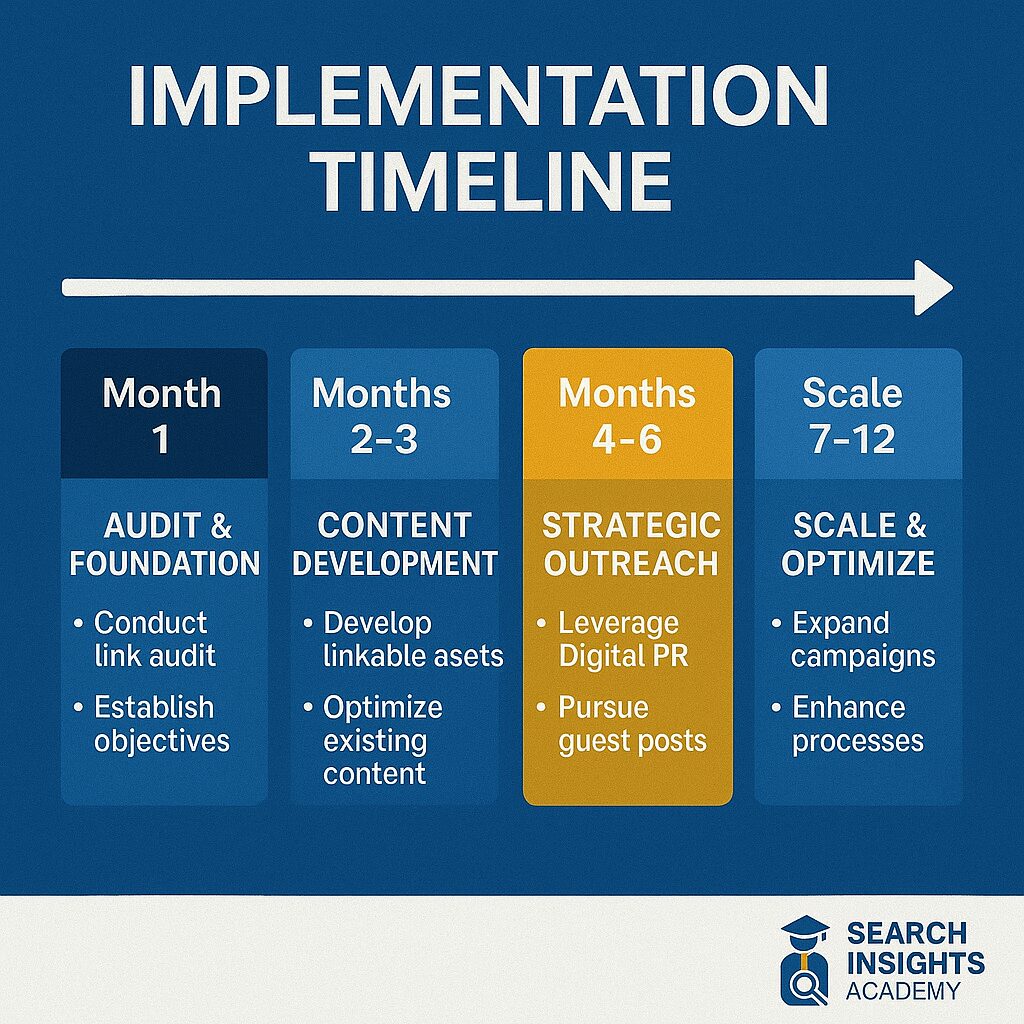
Based on our findings, here’s a pragmatic action plan for implementing advanced link-building strategies:
Month 1: Audit and Foundation
- Conduct a comprehensive backlink audit
- Identify toxic links for disavowal
- Analyze competitor backlink profiles
- Set up monitoring dashboards
- Develop a content asset calendar
Month 2-3: Content Development
- Create link-worthy content assets
- Develop data-driven research for Digital PR
- Optimize existing content for link acquisition
- Build resource pages for broken link targeting
- Prepare guest post topics and pitches
Month 4-6: Strategic Outreach
- Implement multi-touch outreach sequences
- Launch Digital PR campaigns
- Begin broken link building outreach
- Engage in strategic guest posting
- Monitor and adjust based on response rates
Month 7-12: Scale and Optimize
- Double down on highest-converting strategies
- Expand outreach to new prospect segments
- Develop additional content assets based on performance
- Build deeper relationships with key publishers
- Implement AI-assisted prospecting and personalization
Conclusion: The Future of Link Building
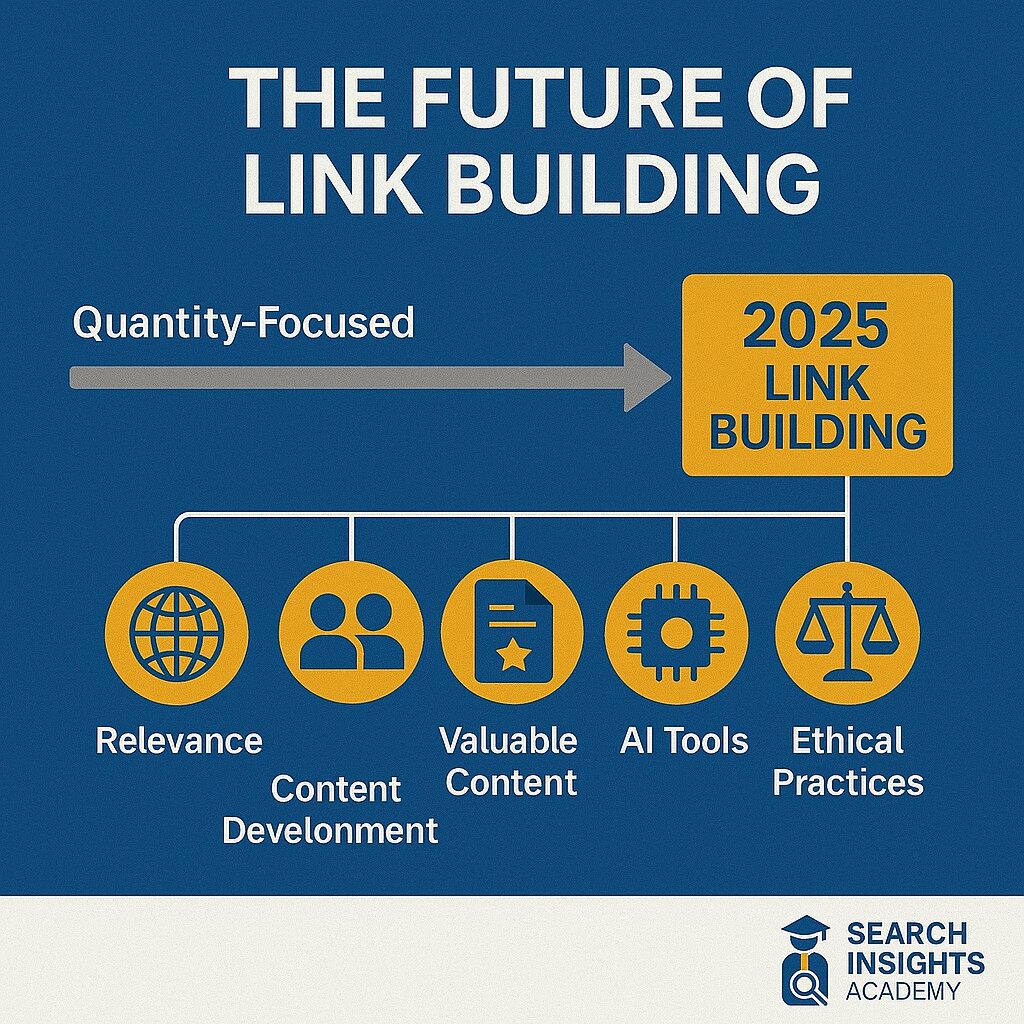
I expect the cost of link building to rise in 2025, which is a good thing. As the actual value of a quality link increases, it should force out the spammy link building practices, link vendors, and marketplaces selling off low-quality links. It will force those remaining to focus on the quality of backlinks, not the quantity, which is more important for your success.
The most successful link builders in 2025 will be those who:
- Prioritize relevance over metrics – Building links that actually drive targeted traffic
- Invest in relationship building – Developing long-term partnerships instead of one-off transactions
- Create truly valuable content – Making assets that genuinely deserve links
- Embrace AI-assisted tools – Using technology to scale personalization, not spam
- Maintain ethical practices – Following Google’s guidelines to ensure sustainable results
By implementing these advanced strategies while remaining adaptable to algorithm changes, you’ll build a link profile that not only boosts rankings but creates real business value through increased referral traffic, brand authority, and audience trust.
Remember that the most effective link building isn’t about shortcuts—it’s about creating genuine value that others want to reference and share. Focus on quality, relevance, and relationships, and your link building efforts will continue to deliver results regardless of how search algorithms evolve.

